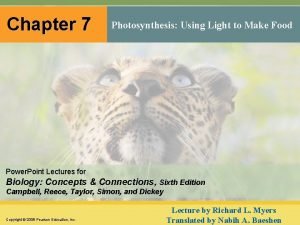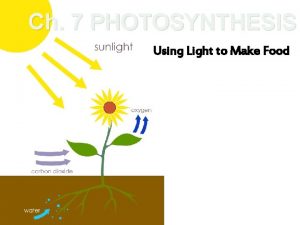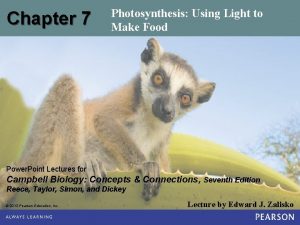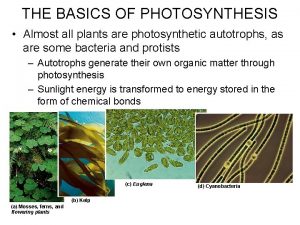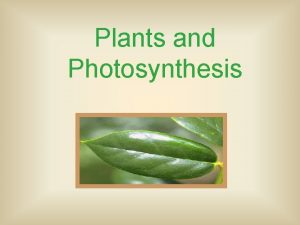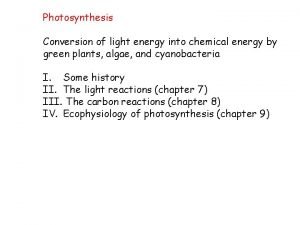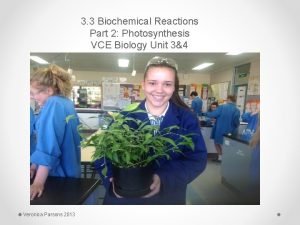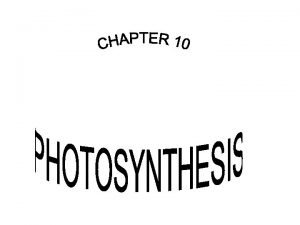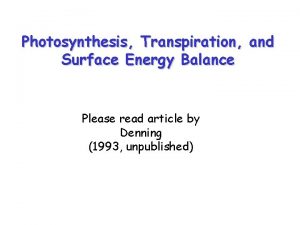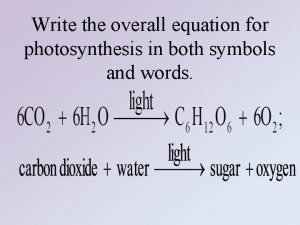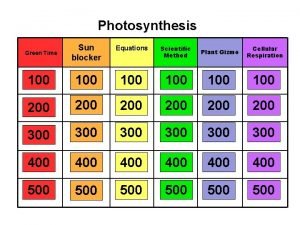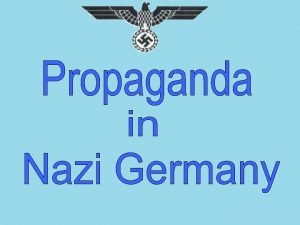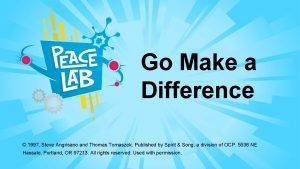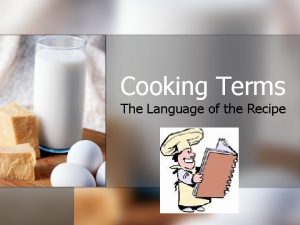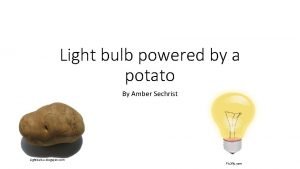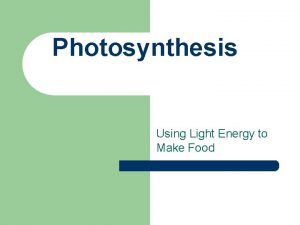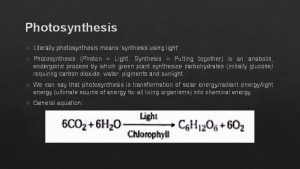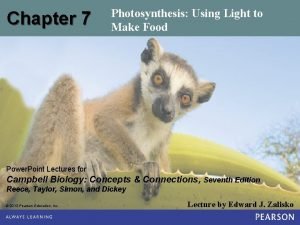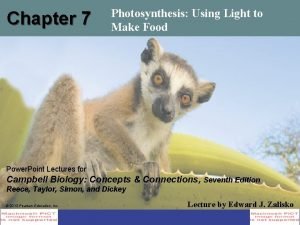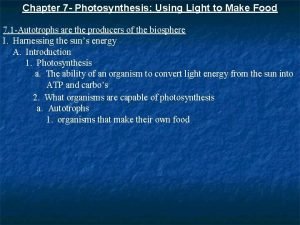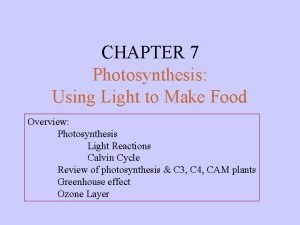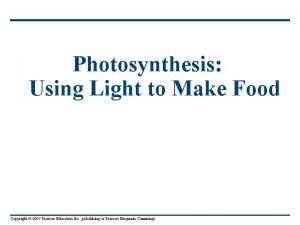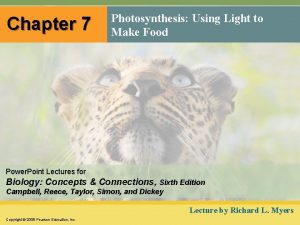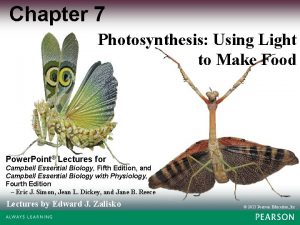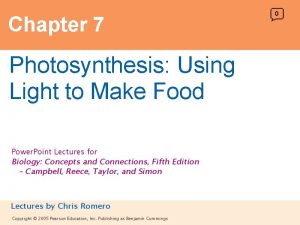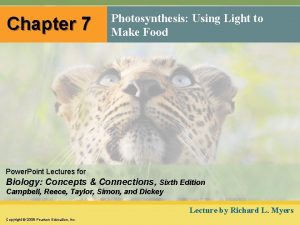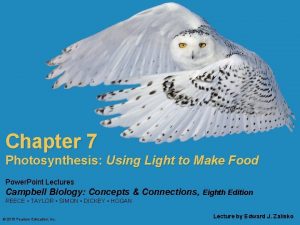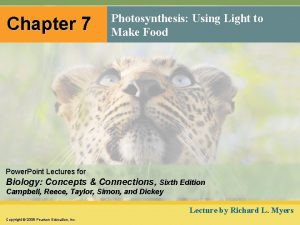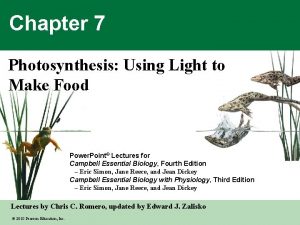Photosynthesis Using Light to Make Food Photosynthesis H

























- Slides: 25

Photosynthesis Using Light to Make Food

Photosynthesis + H 2 O CO 2 Energy Which splits water ATP and NADPH 2 Light is Adsorbed By Chlorophyll ADP NADP Chloroplast O 2 Light Reaction Calvin Cycle Used Energy and is recycled. + C 6 H 12 O 6 Dark Reaction

Plants and Photosynthesis n n Plants are ‘autotrophs’, ie. they can make their own food. Plants are ‘producers of the Biosphere’, ie. They produce food to sustain other living organisms as well. Photo = light; Synthesis = put together. Plant cells have chloroplasts which can capture light energy and convert it into chemical energy – stored in glucose.

The Flow Of Biological Energy Photosynthesis cellular respiration carbohydrates/ energy rich O 2 chloroplast CO 2 + H 2 O for: mitochondria ATP

Chemical Equation for Photosynthesis

Chloroplast n n The chloroplast is the site of photosynthesis. Chloroplasts are concentrated in the mesophyll tissue found in the leaf. Mesophyll tissue is present right under the epidermis of the leaf and consists of Palisade tissue + spongy tissue.

Chloroplast – the Photosynthetic Organelle in Plant Cells

Gases: Where Does the O 2 Come From? n n n CO 2 is taken into the leaf through stomata for photosynthesis. O 2 is released out of the leaf through stomata as a product of photosynthesis. In order to determine whether the O 2 gas product came from the reactant CO 2 or from H 2 O, scientists used tracer (radio-isotopic) Oxygen, first in CO 2 and then in H 2 O as follows:

Fate of Atoms in Photosynthesis n n It was proved from the above experiment that the O 2 product came from splitting of the reactant H 2 O molecule. Consequently, the fate of all the atoms in the chemical reaction of photosynthesis were determined:

Photosynthesis and Cellular Respiration n n Both Photosynthesis and Cellular Respiration are Redox reactions, but they are reverse of each other. Whereas Photosynthesis is an endergonic reaction, Cellular Respiration is an exergonic reaction.

Two Stages of Photosynthesis n Photosynthesis occurs in two stages, viz. Light reactions (during day-time only, in the thylakoid membrane) and Calvin Cycle (both day and night, in the stroma), which are linked together by NADPH and ATP.

Light Used in Photosynthesis n n n During Photosynthesis, the chlorophyll pigments can absorb only some wavelengths of the visible light from the electromagnetic spectrum. Visible light consists of the following colors or wavelengths in order of increasing wavelengths / decreasing energy: Violet, Indigo, Blue, Green, Yellow, Orange and Red. The grana of the chloroplasts absorb mainly blueviolet and red-orange lights. Green light is reflected and transmitted by green plants – hence, they appear green.

Light n n Photon = a discrete packet of light energy. The shorter the wavelength, the greater the energy…. and vice-versa.

Pigments of the Chloroplast n n Chlorophyll a directly participates in Light reactions. Chlorophyll b and carotenoids do not directly participate in light reactions.

Light Reaction n n n Light reaction – is dependent on light and occurs only during the day in nature. It takes place in the thylakoid membrane of the chloroplast. Light reactions involve a) Splitting of water to produce oxygen, b) Energy production (ATP) and c) Reduction of NADP+ to NADPH.

Basic steps of a Light Reaction n n Light reaction involves the following basic steps: 1) Absorption of light 2) Excitation of Chlorophyll a and emission of electron 3) Formation of ATP and NADPH via the electron transport chain

Components of Light Reaction n n Light / Solar Energy / Photon Reaction Center = Chlorophyll a and primary electron acceptor Antenna = Reaction center and other pigment molecules that gather light. Photosystem = Antenna + Reaction center.

Photosystem II n n n In Photosystem II, chlorophyll a molecule is the reaction center. This molecule absorbs orange-red light which has a higher energy level. Its excited state (due to light absorption) emits electrons that are accepted by a primary electron acceptor and passed down an electron transport chain, eventually replenishing the lost electrons from Photosystem I. H 20 is split into H+ (protons), electrons and Oxygen gas. These electrons replenish the lost electrons from Photosystem. II.

Photosystem I n There are two types of Photosystems, (viz. Photosystem I and Photosystem II) occuring within the thylakoid membrane. n Its excited state emits electrons which are accepted by the primary electron acceptor and passed down an electron transport chain, eventually reducing NADP+ to NADPH.

Photosystems I and II

Calvin Cycle (Light Independent Cycle) n n n Calvin Cycle – named after Dr. Calvin It takes place in the stroma of the chloroplast. Calvin Cycle involves the production of ‘food’ as glucose, with the utilization of CO 2, energy and NADPH.

Calvin Cycle (TCA) or Dark Reaction n n The Calvin Cycle can take place during the day and the night in the stroma of the chloroplast. It is powered by ATP and NADPH, synthesized during the light reactions – therefore, Calvin cycle depends upon the products of Light reaction.

Calvin Cycle - Continued n n The Calvin Cycle utilizes CO 2 in ‘carbon fixation’ which is finally converted into Glucose. An excess of glucose is converted into starch – stored in roots, tubers and fruits.


The Calvin Cycle con’t n n n (TCA) Carbon dioxide fixation. The NADPH and ATP from the light reaction provide the energy for producing glucose from carbon dioxide. This takes place in the stroma of the chloroplast. a. 6 molecules of CO 2 enter the cycle. Rubisco, an enzyme, is responsible for fixing CO 2 to an existing molecule. b. 6 molecules of Ribulose phosphate (5 -C each) affix 6 CO 2 to make 12 phosphoglycerates (PGA) (3 -C each) c. ATP and NADPH are used to convert these to 12 phosphoglyceraldehydes (PGAL) (3 -C each) d. 2 PGAL are removed to make glucose, while 10 return to remake 5 Ribulose phosphates (5 -C each).
 Chapter 7 photosynthesis using light to make food
Chapter 7 photosynthesis using light to make food Using light to make food
Using light to make food Using light to make food
Using light to make food What is the word equation of photosynthesis
What is the word equation of photosynthesis Green plants make their own food by photosynthesis
Green plants make their own food by photosynthesis Light light light chapter 23
Light light light chapter 23 Light light light chapter 22
Light light light chapter 22 Chapter 22
Chapter 22 Unit 2 food food food
Unit 2 food food food Food chain sequence
Food chain sequence Inputs of light reactions in photosynthesis
Inputs of light reactions in photosynthesis Granum
Granum Photosynthesis equation light reaction
Photosynthesis equation light reaction How to measure photosynthesis
How to measure photosynthesis Photosynthesis reaction
Photosynthesis reaction Light and dark reactions of photosynthesis
Light and dark reactions of photosynthesis Photosynthesis transforms light energy into chemical energy
Photosynthesis transforms light energy into chemical energy Overall equation for photosynthesis
Overall equation for photosynthesis The food that plants produce during photosynthesis is
The food that plants produce during photosynthesis is Photosynthesis food chain
Photosynthesis food chain Make the lie big keep it simple
Make the lie big keep it simple Steve angrisano go make a difference
Steve angrisano go make a difference Make the lie big make it simple
Make the lie big make it simple Pare culinary definition
Pare culinary definition Light a bulb with potato
Light a bulb with potato Put out the light, and then put out the light
Put out the light, and then put out the light
